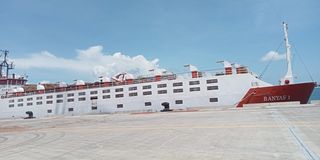
The MV Banyas 1 livestock carrier vessel at Lamu Port on December 6,2022.
When Kenya launched its livestock export initiative to Oman via the new Sh310 billion Lamu Port in October 2022, it was hailed as a game-changer for pastoralists.
The long-anticipated opportunity promised direct access to international markets and significant investment from herders across Lamu and neighbouring pastoralist regions in North Eastern Kenya.
Nearly three years later, many say the promise remains unfulfilled and the dream is slipping away.
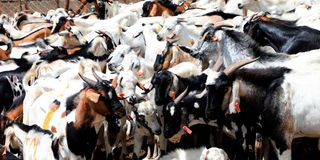
This photo, taken on October 15, 2022, shows livestock for export to Oman being quarantined near Lamu Port, ahead of loading onto the Mv Banyas 1 Lome Vessel.
Mr Noor Hassan, 50, a pastoralist from Koreni in Lamu West was among those who viewed the venture as life-changing. After hearing in mid-2022 that livestock exports through Lamu Port would begin by the end of the year, Mr Hassan increased his investment in livestock farming.
“I believed a readily available international market would be established at Lamu Port once the Oman export trade commenced,| said Mr Hassan.
At the time, he owned around 80 goats, 60 sheep and 100 head of cattle. After attending several sensitisation meetings where he learned that only male livestock would be considered for export, Mr Hassan sold most of his cows to invest in bulls.
“Of the 100 head of cattle, I had about 60 cows. I sold 50 of them and got Sh400,000. I added another Sh120,000 and purchased 15 young bulls,” he explained.
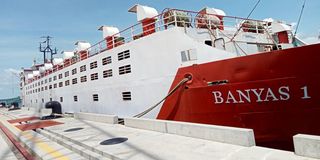
The Togolese specially designed livestock transport vessel MV Banyas 1 at Lamu Port. The ship left the facility to the Port of Salalah in Oman on Saturday, ferrying 2,955 animals.
He was ecstatic when the livestock export trade was officially launched on October 16, 2022. During the inaugural shipment which saw over 15,000 bulls, sheep and goats sent to Oman Mr Hassan was among the few local herders who managed to sell their animals. However, that early success was short-lived.
“I am disappointed. I only sold five bulls, 15 goats, and 10 sheep in October 2022. Since then, there have been no updates about when livestock will be needed at Lamu Port. Yet we keep seeing trucks full of cattle, goats, sheep and camels — headed to the port, meaning the business is ongoing,” said Mr Hassan.
“I invested heavily in livestock keeping, hoping to earn good money. Unfortunately, that dream has not materialised. We are being left in the dark and we deserve to be prioritised,” he added.
Chairperson of the Lamu Pastoralist Community Muhumed Kalmei voiced similar frustrations accusing the port management of sidelining local herders.
“Since the livestock export trade via Lamu Port began, it has been shrouded in secrecy. We expected to benefit directly from this venture,” Mr Kalmei said.
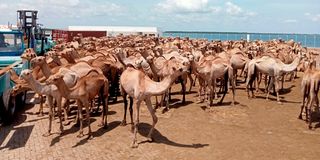
Camels at Lamu Port ready to be exported to Oman via the Togolese livestock-carrier vessel MV Banyas 1 on December 6, 2022.
He claimed that most of the exported livestock comes from other regions such as Garissa, Tana River, Wajir, Mandera, Turkana and Isiolo while local herders are overlooked.
“We are more than 10,000 pastoralists in Lamu. Who says we cannot supply enough livestock for the port? All we need is timely communication about when the livestock-carrier vessels are arriving so we can organise ourselves accordingly,” he added.
Mr Abdelrahman Abdi, a herder from Pangani area said he invested over Sh800,000 in livestock, banking everything on the Lamu Port promise. Yet, he has not sold a single animal through the facility.
“Sometimes I’m forced to sell goats, sheep, and even bulls locally but that was not my original plan. I’m hoping and praying that the port management will one day engage us. I want to experience the benefits of the livestock export trade through our own port,” said Mr Abdi.
However, in response to the outcry, Kenya Ports Authority (KPA) General Manager for Lamu Port Vincent Sidai denied claims that local farmers are being sidelined. He attributed the slow progress to an inadequate supply of livestock.
“No one is being ignored. We are encouraging herders to bring their animals. We have a ready market for livestock at Lamu Port. Even if an individual brings 5,000 animals, we will guide them,” Mr Sidai said.
Since 2022, only 150,000 head of livestock have been shipped to Oman, a figure considered too low to sustain regular shipping operations.
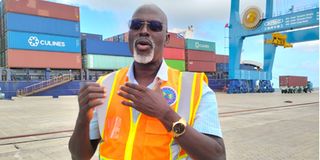
Lamu Port General Manager, Eng Vincent Sidai addressing journalists at Lamu Port site in Kililana, Lamu West on June 5,2025.
“One livestock-carrier vessel calling at Lamu Port typically needs a minimum of 5,000 animals. This has been a challenge,” he said.
Despite the enthusiastic launch, shipments have slowed with vessels such as the Togolese MV Banyas 1 often waiting weeks or even months in port while livestock is sourced from different parts of Kenya.
To address this, the government is constructing a dedicated livestock terminal at Lamu Port to better accommodate large volumes.
Mr Sidai also revealed that a private company has set up offices and yards and has acquired its own livestock-carrier vessel, MV Mahmoud, to streamline trade between Lamu and Oman.
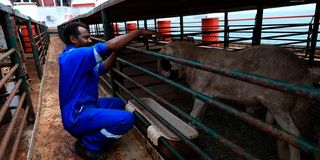
An employee cleans a sheep inside MV Banyas 1 Lome Vessel at the Port of Lamu on October 15, 2022. The vessel will transport livestock for export to Oman.
“This company collects livestock from across the country, handles fattening, vaccinations and all animal health requirements before exportation,” he explained.
Despite the challenges in the livestock trade, Lamu Port has recorded progress in other areas. Since it began operations in 2021, over 100 vessels have docked.
That year, it received 12 vessels; in 2022, only four.
In 2023, the number rose to 36 but dropped again in 2024 to 20. By June 2025, the port had already received 34 container vessels, with more expected.
A livestock-carrier vessel originally expected in June 2025 is now scheduled to dock in early July to ferry 5,000 goats to Oman.
Lamu Port remains a crucial component of the Sh2.5 trillion Lamu Port–South Sudan–Ethiopia Transport Corridor, one of East Africa’s most ambitious infrastructure projects.






